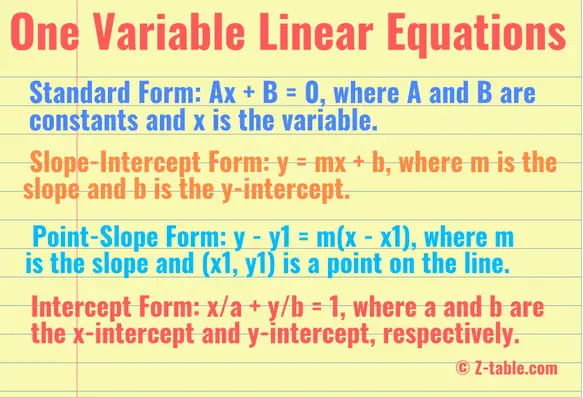One Variable Linear Equations
One-variable linear equations can be classified into different types based on their characteristics and properties. In this article, we will discuss each type of one-variable linear equation in detail.
In this equation, the slope is 3, and the y-intercept is -2.
- Standard Form: The standard form of a one-variable linear equation is Ax + B = 0. In this equation, A and B are constants, and x is the variable. To solve this equation, we would first isolate the x-term by subtracting B from both sides and then divide both sides by A. For example, the equation 2x + 5 = 9 can be solved as follows:
- Slope-Intercept Form: The slope-intercept form of a one-variable linear equation is y = mx + b, where m is the slope of the line, and b is the y-intercept. To convert a standard form equation to slope-intercept form, we would first solve for x and then rearrange the equation. For example, the equation 3x - 2 = y can be converted to slope-intercept form as follows:
In this equation, the slope is 3, and the y-intercept is -2.
Point-Slope Form: The point-slope form of a one-variable linear equation is y - y1 = m(x - x1), where m is the slope of the line, and (x1, y1) is a point on the line. To convert a standard form equation to point-slope form, we would first solve for x and then plug in the values for (x1, y1) and m. For example, the equation 4x - 3 = y can be converted to point-slope form using the point (1, 1) as follows: 4x - 3 = y y - 1 = 4(x - 1) y - 1 = 4x - 4 y = 4x - 3
In this equation, the slope is 4, and the point (1, 1) lies on the line.
6x - 3 = 2y y = 3x - 3/2 x/1/2 + y/(-3/2) = 1
In this equation, the x-intercept is 3, and the y-intercept is -2.
One-variable linear equations involve only one variable and can be written in various forms, such as standard form, slope-intercept form, point-slope form, and intercept form. Each form has its own characteristics and properties, making it useful in different situations. Understanding the different types of one-variable linear equations is crucial for solving real-world problems and making predictions in various fields.
In this equation, the slope is 4, and the point (1, 1) lies on the line.
- Intercept Form: The intercept form of a one-variable linear equation is x/a + y/b = 1, where a and b are the x-intercept and y-intercept, respectively. To convert a standard form equation to intercept form, we would first solve for x and y and then divide each term by the constant C. For example, the equation 6x - 3 = 2y can be converted to intercept form as follows:
6x - 3 = 2y y = 3x - 3/2 x/1/2 + y/(-3/2) = 1
In this equation, the x-intercept is 3, and the y-intercept is -2.
One-variable linear equations involve only one variable and can be written in various forms, such as standard form, slope-intercept form, point-slope form, and intercept form. Each form has its own characteristics and properties, making it useful in different situations. Understanding the different types of one-variable linear equations is crucial for solving real-world problems and making predictions in various fields.
If you need to calculate linear equations check out these resources:
To test you knowledge of linear equations take our tests with answers and explanations:
To test you knowledge of linear equations take our tests with answers and explanations:
